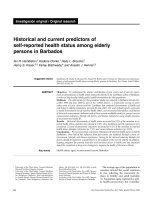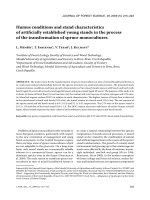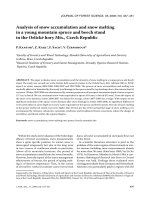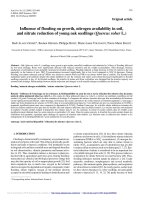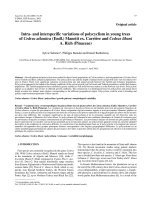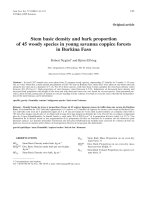Understanding young singaporeans gathering and credibility assessments of online sexual health information 1a
Bạn đang xem bản rút gọn của tài liệu. Xem và tải ngay bản đầy đủ của tài liệu tại đây (531.68 KB, 67 trang )
UNDERSTANDING YOUNG SINGAPOREANS’
GATHERING AND CREDIBILITY ASSESSMENTS
OF ONLINE SEXUAL HEALTH INFORMATION
SITI NURHARNANI BINTE NAHAR
BSocSc.(Hons.), National University of Singapore
A THESIS SUBMITTED
FOR THE DEGREE OF MASTER OF ARTS
COMMUNICATIONS AND NEW MEDIA PROGRAMME
NATIONAL UNIVERSITY OF SINGAPORE
2010
ii
To Ayah & Ibu,
iii
Acknowledgments
Really great people make you feel that you, too, can become great.
Mark Twain
I would like to express my appreciation to family, friends, mentors and
colleagues for their support during the course of my completion of this
Masters dissertation. Specifically, I wish to thank my supervisor, Dr. Lim Sun
Sun for her guidance in completing this thesis. I especially appreciate the
precious feedback by Dr. Millie Rivera, Dr. Cho Hichang, as well as fellow
graduate students in the graduate seminar, theories, and methods classes. I
want to extend a big thank you to my family, friends and colleagues for
assisting me in getting respondents for my fieldwork. And special thanks to
my fellow TAs, administration and technical support ladies for being there
during my occasional ranting.
I would also like to take this opportunity to thank new friends - my
respondents and the Health Promotion Board for making this completion
possible. My respondents were not only willing to share their experiences with
me; they also took the extra mile and roped in more participants. And to the
Health Promotion Board, I am appreciative of their assistance and support.
Most importantly, I am thankful to God for giving me strength and
endurance, my parents, and brother for their love, support and occasional
waivers from household chores. And, I would like to give special mention to
Ck who was my bastion of support with his unwavering belief, constant supply
of resources, wake-up calls, and keeping me sane.
iv
Table of Content
Acknowledgments
Table of Contents
List of Appendices
List of Tables
List of Figures
Abstract
Chapter One – Significance and Background Information
1.1. Objectives of Study
1.2. Background Information
1.2.1. Defining Youths
1.2.2. Profile of the Singaporean Youth
1.2.3. Sex Education in Singapore
1.3. Sequence of Presentation
1.4. Conclusion
2
5
6
6
7
12
17
18
Chapter Two – Literature Review
2.1
Nature of the Internet
2.2
Information Seeking
2.2.1. Personal Locus
2.2.2. Knowledge Structure
2.2.3. Skills
2.3
Review of Existing Literature and Information Gaps
2.4
Summary
21
22
23
28
29
31
35
42
Chapter Three – Research Methodology
3.1
Self-Confrontation Interview
3.2
Strengths of the Self-Confrontation Interview
3.3
Research Methods considered
3.4
Sampling, Selection Criteria and Actual Respondent Profiles
3.5
Interview Administration and Procedure
3.6
Coding Frame and Interview Guide
3.7
Analysis of Data
3.7
Conclusion
44
45
47
48
49
55
60
62
62
Chapter Four – Findings and Discussion
4.1
Personal Locus
4.1.1 Attitudes of respondents
4.1.2 Convenience and speed
4.1.3 Other concomitant factors
4.2
Knowledge Structure
4.2.1 Search string permutations
4.2.2 Navigation within websites
4.2.3 Keying of web addresses
4.2.4 Use of bookmarks
4.3
Skills
4.3.1 Search engines
64
65
66
68
70
70
72
76
77
78
82
83
v
4.4
4.5
4.3.2 Websites
4.3.3 Information seeking process
Personal Influences and Nature of Information
Conclusion
85
87
107
110
Chapter Five – Conclusion
5.1
Key Findings and Recommendation to Increase Media Literacy
5.2
Limitations and Future Research
112
112
116
Bibliography
118
List of Appendices
Appendix 1.1 Overview of Singapore Education Landscape
Appendix 1.2 Figures and tables extracted from IDA Annual Survey
on Infocomm usage in households and by individuals
Appendix 2.1 Blurbs of 2001 to 2010 studies related to young people,
Singapore, sexual health and/or Internet
Appendix 3.1 Age-group statistics according to ethnic group
Appendix 3.2 Detailed Profiles of Respondents
Appendix 3.3 Coding
Appendix 3.4 Interview Guide
List of Tables
Table 3.1a
Table 3.1b
Table 3.2a
Table 3.2b
Table 3.3
Table 3.4
Table 4.1
Table 4.2
Table 4.3
Variables for Maximum Variation Sampling
Sampling based on gender, ethnicity and institution type
Profiles of Respondents
Detailed Profiles of Respondents
Pre-interview questionnaire
Sample of Instruction and Task List
Different permutations of search strings
Respondents and time spend on Internet daily
Different types of websites and websites visited
List of Figures
Figure 1.1
Figure 1.2
Figure 3.1
Figure 3.2
Figure 4.1
Figure 4.2
Figure 4.3
Figure 4.4
Figure 4.5
Figures 4.6
Figure 4.7
Figure 4.8
Figure 4.9
Figure 4.10
Sex + Body column in Teen magazine
Question & Answer in Teen Confidential column
Overall Sampling of Study
Second screen capture which allows for matching pauses and audio
Images from Google
Video from YouTube
List of protection methods grouped
List of protection methods grouped by gender
Examples of search aids
Spelling mistakes
Ali was attracted to the graphics
Ads presented within content
Ads presented within content
Pages that were possibly read instead browsed by respondents
vi
Abstract
There is little literature which explains how young people seek and
assess online sexual health information. Also, there is still a gap in
understanding the part that media literacy plays when young people sieve
through the myriad sources for credible information. With the plethora of
information online and the rise of user-generated content, this comprehension
of their manner of assessment serves to be increasingly pertinent. Given this
milieu, the main focus of this paper is to understand the influences and
thought processes of young people in seeking sexual health information.
In December 2008, the study recruited 36 Singaporeans between the
ages of 17 and 21 to participate in a self-confrontation interview study, using
Camtasia studio. Although the interview sessions indicate that young people
are equipped with basic media literacy skills, there is still a gap in youths’
information seeking. Also, often, youths become absorbed in only gathering
information that they do not stop to evaluate them. Therefore, youths still need
to be equipped with strong knowledge structures, to be in control of their locus
in looking for information, and to continually upgrade their skills through
frequent use. In order to aid these youths, the school curriculum needs to
move from the trend of functional media literacy to that of critical literacy.
Keywords: Internet; information-seeking, media literacy; health literacy;
electronic health information; sexual health information; young people
between 17 and 21; Singapore
Chapter 1
Significance and
Background
Information
Chapter One
Significance and Background Information
Traditionally, books, newspapers, magazines, television, radio, family,
and friends were the main sources of information for the masses. In the
information age today, the Internet has dominated that role – rivalling the
aforementioned old media and bringing about tremendous change in the way
people obtain information. The current youth population has not been spared
from this change, and the Internet plays a big part in their lives. Today, a
youth is more likely to look for information using a search engine rather than
visiting the library (Palfrey & Gasser, 2008). The Internet allows them to be
involved in these activities under different parameters, via anonymity and
simultaneity (de Kerckhove, 1995). Youths preferentially use the web as an
information resource because compared to traditional media, the Internet
maintains a 24–hour presence, allows for private browsing while still receiving
current information, and boasts fast search capabilities (Pierce, 2007; Stern &
Willis, 2007; Suzuki & Calzo, 2004).
As for Singaporean youths, recent newspaper articles suggest that one
use of the Internet is to retrieve information on sex-related topics. They also
use blogs to pen their sexual adventures, share sex tips on various forums,
and engage in cyber-sex using various online communication applications
such as Instant Messaging (Shuli, 2008; Teo, 2008; Toh, 2007). This is a
trend that requires greater attention because in the absence of sufficient and
accurate sex information, youths have been found to depend greatly on the
media for such information and guidance (Strasburger, 2005; Weimann,
2000).
2
As for the content available on the Internet, studies show an increased
delivery of sexual and reproductive health promotion information, and this is
due to sexuality and reproductive health education efforts. They aim to
provide individuals with information, motivation, and behavioural skills that will
enable individuals to avoid sexual and reproductive health problems and
achieve well-being in this area (Barak & Fisher, 2001; 2003; Fisher & Fisher,
1992; 1999). There are also websites which are commercially-driven, and
other websites which are uploaded by private individuals.
Despite the motives behind these efforts, the plethora of information
online has resulted in a cause for concern about quality of the information
online. Participatory Web gives rise to a complication, which relates to
information quality. One of the big changes wrought by the use of the Internet
is the way in which individuals can easily create and consume information and
knowledge. With a lack of universal standards for posting information, online
information may be easily modified, plagiarised, misrepresented, or even
created under false pretences (Fritch & Cromwell, 2002; Johnson & Kaye,
2002; Metzger, Flanagin, Eyal, Lemus, & McCann, 2003; Rieh, 2002).
Information quality issues are neither Internet-specific nor new to the digital
age, however, the availability of user-generated content has made it more
difficult to distinguish accurate and inaccurate information. However, there are
concerns about the challenges that youths are facing, having to grow up
surrounded by numerous information sources that allow anyone become an
author or an editor (Palfrey & Gasser, 2008; Metzger, 2007).
In relation to the Singapore context, this lack of gate-keeping is
worrying as 91% of Singaporeans who receive information from the Internet
3
have taken action in response to the information gathered (Siow et al., 2003).
Also, 45% of Singaporean Internet surfers of health content consider online
health information trustworthy if the information is from a professional source
or if the website displays the source, while 10% trust the information if it
concurs with the doctor’s advice (Siow et al., 2003).
Currently there is a gap in literature pertaining to youths’ assessment of
health information online; with only several studies conducting research in this
area (eg. Metzger, 2007; Rieh & Hilligoss, 2008). Firstly, this is because
extant research has primarily been about information searching where
researchers examine the kind of information respondents acquire and learn
(Chelton & Cool, 2007; Chelton & Cool, 2004 as cited in Chelton & Cool,
2007). It is only in recent years that studies have shifted towards information
seeking in a bid to explain how respondents look for information (Chelton &
Cool, 2007; Chelton & Cool, 2004 as cited in Chelton & Cool, 2007). Next,
despite the growing body of literature on the Internet and healthcare, with the
exception of research on college students, there are few empirical studies of
youths' usage of the Internet for health information, and even fewer
concerning sexuality issues (Gray & Klein, 2006). There is also limited
research on how youths learn about sexuality from the media (Strasburger,
Wilson, & Jordon, 2009). The literature gap in youths’ usage of sexual health
information exists as the sensitivity of the issue has resulted in such literature
being skewed towards situating adults and college students as the subjects of
research. In the case of Singapore, prior studies of the situation have found
that 27% of young Singaporeans aged 13 to 19 and 37% of those aged 20 to
29 use the Internet to look for health information (Siow et al., 2003). Of such
4
Internet surfers aged 13 to 55, 25% choose the Internet as the second top
preferred source (Siow et al., 2003). Notwithstanding the value of Siow’s
study, there is still a lack of qualitative and quantitative academic research on
Singaporean youths’ usage of the Internet to search for sexual information.
This thesis seeks to fill the aforementioned gaps and to contribute to
research on Internet studies pertaining to youths. Given that a high
percentage of Singaporeans take action from the health information which
they gather, the findings from this paper will be significant as it will enable
better understanding of youths’ concerns in seeking sexual health information.
With this understanding, steps can then be taken to better tailor future literacy
programs.
1.1 Objectives of Study
The thesis seeks to examine young Singaporeans’ thought processes,
and cater to their competency levels to understand the selection of online
information in their exploration of sexual health topics. It concerns itself with
youths’ evaluations of the multitude of information online by studying the
factors that influence their information search. It also will explore how youths
assess the credibility of online sexual health information.
The thesis will focus specifically on young people between 17 and 21
years old. It mainly seeks to capture information seeking among youths who
have just completed their education in secondary schools to those attending
universities. There are several reasons why this age-group is chosen. Firstly,
it is interesting to study the digital natives who assert that they are web
experts (Livingstone, 2007). Next, a high percentage has Internet access -
5
83% of Singaporeans aged between 15 and 30 access the Internet at any
location (IDA, 2007). Also, this age group is significant as it is a
developmental
phase
independence,
peer
manifested
influence,
by
sexual
identity
formation,
coming-of-age
and
increased
risk-taking
behaviour (Donovan & Jesser, 1985; Strasburger, Wilson, & Jordon, 2009).
Moreover, there is little research done on this age group as a result of
inherent problems in doing research on youths’ knowledge, attitudes and
behaviour toward sexual media content and sexuality (Gray & Klein, 2006;
Wartella, Scantlin, Kotler, & Donnerstein, 2000). Previously, the main barrier
was youths’ concerns about confidentiality. Therefore, past studies on youths
were mainly conducted on university students. For this reason, this paper
aims to fill the literature gap by examining a slightly younger age group.
1.2 Background Information
In this section, the paper will define young people, provide their
background information, as well as present their behavioural traits. In
considering youths’ information seeking behaviour, it is also imperative that
we understand what it means to be a Singapore youth. Therefore, the paper
will present a profile of young Singaporeans. An understanding of their
educational, technological, social, familial, sexual backgrounds will better
contextualise our understanding of their media engagement.
1.2.1 Defining Youths
In this paper, young people, young adults, and youths will be used
interchangeably as they are common terms used to denote the group of
6
people who are caught between childhood and adulthood. The United Nations
1985 General Assembly defines the term youth as “those persons falling
between the ages of 15 and 24 years inclusive” (United Nations, 2007). Youth
is a “demographic concept that has both biological and sociological aspects
(Atal, 2005, p.10).” However, sociologically it is a category, not a group; and a
category may consist of several groups. This is because although
categorically, this concept is represented by certain biological attributes, with
the roles and expectations associated with it differing from culture to culture
(Atal, 2005). During this period, relationships and peer culture also take on
important roles in explaining youths’ choices (Wolfe, Jafee & Crooks., 2006).
In addition, the media plays an integral part in young people’s communication,
general knowledge, comprehension of the world and relation to other people
(Kenway & Bullen, 2001).
In coping with transition into adulthood, youths inevitably experiment in
risky behaviours. Risky behaviours, relating to substance use, sexual activity
and extreme sports activities occur when youths with limited or no experience
engage in behaviours in anticipation of benefits without comprehending the
immediate or long-term consequences of their actions (Irwin & Millstein,
1992). Conducting risky activities may be a function of adolescent
egocentrism – these youths think that they are unique and that misfortunes
will happen to someone else, not them (Strasburger, Wilson & Jordon, 2009).
1.2.2 Profile of the Singaporean Youth
Termed as “the parents, decision-makers, business people and leaders
of tomorrow [n.p.]” (National Youth Council, 2006), young people in Singapore
7
are invaluable to a nation that depends on human capital as its main
resource. As at the end of June 2007, young Singaporeans between the ages
of 15 and 24 constituted 475,000 out of the country’s 3.58 million citizens
(Singapore Department of Statistics, 2008). Youths in Singapore are welllearned, highly connected to the Internet, and participate in offline and online
activities. These associations to Singaporean youths will be elaborated in the
following sections.
Firstly, on the issue of education, Singapore passed the Compulsory
Education Act in 2000, and it states that “a child of compulsory school age is
one who is above the age of 6 years and who has not yet attained the age of
15 years” (Ministry of Education, 2008). An overview of the 2010 Singapore
education landscape is available in Appendix 1.1. The overview illustrates that
students in Singapore would have obtained a satisfactory level of education.
Next, being “the most wired nation” with a household broadband
penetration rate of 99.9% as of December 2008, the use of the Internet in
Singapore is close to saturation (Tan, 2009). The Ministry of Education (MOE)
promotes ICT use in schools by providing network infrastructure, hardware,
and curricular support. In schools, using ICT is integrated into 30% of
curriculum period through its use in lessons, online learning portals, and
educational games (Koh, 2007). Therefore, with regards to youths’ media
consumption, this means that it is fairly common for Singaporean students,
even at primary schools, to research, prepare, and even submit homework
using the Internet. In fact, the 2008 annual survey on households’
infocommunications usage shows that among Singaporean youths aged 15 to
24, 99% have access to computers at any location and 98% are Internet
8
users (IDA, 2009). 78% of the youths use the Internet at least once a day
(IDA, 2009). Their top three uses of the Internet are for communication,
leisure activities and getting information (IDA, 2009). Getting information is
one of the top three Internet activities carried out by youths between ages 15
to 29 years old (IDA, 2007). Research from the World Internet Project (2009)
findings indicate that 73% of Internet users in Singapore aged 18 and older
consider the Internet to be an important / very important source for
information, and 79% use the Internet several times a day / daily / weekly to
get information for school related work. The full figures and tables are
available at Appendices 1.2a, b, c and d. Hence, with the basic IT knowledge
learnt from schools, and daily Internet usage, the youths would have sufficient
media literacy to gather information online.
Similar to youths in other countries, youths in Singapore dabble in
many activities during this transition period. These activities may include
those which put them at risk. In Singapore, at-risk youths refer to “those who
have been subject to a combination of interrelated biological, psychological,
and social factors that result in greater likelihood for the development of
delinquency, substance abuse, or other related anti-social and self-destructive
behaviours” (Inter-Ministry Committee on Youth Crime, 2002, p. 5). In
particular, the next paragraphs look at risks related to sex as youths who
engage in risky sexual behaviour may be vulnerable to sexually transmitted
diseases, unwanted pregnancies, and dangers of unsafe abortions (United
Nations World Youth Report, 2007).
With regards to legal statutes relating to sex, the minimum legal age for
(a) engaging in sexual intercourse and (b) watching movies categorised as
9
Restricted Artistic R(A) are 16 and 21 years of age respectively (National
Youth Council, 2006). However, past studies show that (a) the average age
that Singaporeans initiate sexual activities is between 14 to 15 years, (b) the
first sex encounter is 18.9 years, and (c) a Singaporean youth has an average
of 5.8 sex partners (Durex, 2005; Fei Yue, 2002, as cited in A to Z Guide on
Singapore Youth). 30% know their friends are having sex, 40% have half or
less than half of their friends believe in abstinence from pre-marital sex, 60%
have several, if not many friends, who hold permissive values towards premarital sex (Fei Yue, 2002, as cited in A to Z Guide on Singapore Youth). For
the 52% of youths who view pre-marital sex as being acceptable, being
curious, satisfy desire, and love are the three cited reasons for having premarital sexual intercourse (Fei Yue, 2002, as cited in A to Z Guide on
Singapore Youth). Despite the relatively high number of youths who are for
pre-marital
sex,
48% Singaporean
youths
view pre-marital sex as
unacceptable even when two people love each other (Fei Yue, 2002, as cited
in A to Z Guide on Singapore Youth). Most students, especially females, say
that they are able to resist pressures or temptations when they encounter
situations where they are pressured or tempted to having sex (Fei Yue, 2002,
as cited in A to Z Guide on Singapore Youth). These pro-abstinence youths
explain the top reasons with which they uphold their stand: (a) getting
HIV/AIDS and other sexually-transmitted diseases, (b) becoming pregnant
and (c) losing self-respect (Durex, 2004).
In recent years, there has been increasing public concern in Singapore
over “teenage pregnancies, abortions, HIV infection, abandonment of babies
by teenage parents, [and] sexual abuse of children” (Ministry of Education,
10
2000). Teenage pregnancies and the higher rates of STIs indicate that some
youths are sexually active and are having unprotected sex (Ministry of
Education, 2009). With regards to safe sex practices, 74% of young
Singaporeans display relatively high awareness of them by indicating that the
condom is the most effective method of preventing sexually transmitted
diseases (Chuah, 2007). However, only 36% say that they use contraceptives
all the time. Statistics show an increase in the number of HIV infected
Singaporeans between ages 10 to 19 and 20 to 29 years old from 2006 to
2008 (Ministry of Health, 2009). Specifically among teens, the number cases
of sexually transmitted infections have increased by 250 per cent from 2002 to
2008 and the number of HIV cases has grown from 1 in 2002 to 9 in 2007
(Ministry of Education, 2009). Such statistics suggest that a small but
significant minority of Singaporean youths are not well informed about sex,
contraception and sexually transmitted diseases.
Lastly, with regards to personal influence, inexperienced youths require
support and advice in making decisions. The National Youth Council reports
that there are “moderately strong relationships between youth and their
families”, since young Singaporeans generally indicate a positive perception
of support from their family. For advice on important decisions, youths turn to
their mothers (75%), followed by their friends (65%), fathers (57%) and
siblings (39%) (National Youth Survey, 2002 as cited in A to Z Guide on
Singapore Youth).
Youths seldom confide their problems to teachers
(National Youth Survey, 2002 as cited in A to Z Guide on Singapore Youth).
Despite the fact that parents are deemed important by youths, more youths
turn to their peers for social support; 79% and 70% indicate that they will turn
11
to their friends and mothers respectively for emotional support (National Youth
Survey, 2002 as cited in A to Z Guide on Singapore Youth). This is because
only few young people have family members paying attention to their
problems and noticing their achievements (National Youth Survey, 2002 as
cited in A to Z Guide on Singapore Youth). Therefore, in the event that youths
have concerns, 25% indicate that they would choose to act on the concerns
themselves, and 28% would ask friends for assistance (National Youth
Survey, 2002 as cited in A to Z Guide on Singapore Youth).
In the next section, the chapter will provide a short introduction on the
sex education landscape and present the sex-related information that is made
available to Singaporean youths if they choose to seek them.
1.2.3 Sex Education in Singapore
Sex education was initiated in the late nineteenth and early twentieth
century by the social hygiene movements in the United States. Early
education centred on information about venereal diseases and its prevention
(Irvine, 1995). Past literature showed various models of school-based sex
education programs and curricula. The two broad types are comprehensive
programs and abstinence-only programs. In the first school of thought, the
conservative models of sex education maintained that for adolescents,
refraining from sex is the only safe and moral choice (Gilbert, 2004). This
program is largely influenced by religious groups; for instance the Christian
Right group likened talking about sex in the classroom to emotional
molestation (Irvine, 2002) where the language is said to provoke and infect
the listeners. The model equates talking about sex with a form of violation on
12
the listener in which the students who hear an invasive vocabulary will catch
the disease of sexual desire. Gilbert (2004) argues that this rhetoric of
protection serves to expand the silence surrounding sexuality in schools. The
second school of thought argues that sex topics should not be taboo because
they are neither provocative nor encourage or promote sex or sexual identities
(Gilbert, 2004). The main objective of this model is to be comprehensive by
offering young people access to information on sex. Therefore the difference
lies in the fact that while conservative educators withhold information,
comprehensive sex education supporters argue that access to information
about sexuality will offer young people the tools to be able to refuse sex.
However, several authors criticise both models for the pathologisation of
sexuality and the rejection of youths’ sexual rights (Britzman, 1998; Patton,
1996).
The content and delivery of sex education vary among different
countries and education systems. This is due to the sensitive nature of the
subject matter which touches on fundamental values and religious beliefs.
Sex education in Singapore was initially a part of the cross-discipline
curriculum. It was covered in the Health Education lesson in Upper Primary
levels; the Science, Civics and Moral Education, and Pastoral Care curriculum
in secondary schools and junior colleges. Schools also invited external
organisations such as the Ministry of Health, family service centres, the
Singapore Planned Parenthood Association among others, to conduct talks
and seminars for students. In 1992, the Ministry of Education also developed
some general guidelines to teach human sexuality in secondary schools.
However, it was only in 2000 that the framework for sex education was
13
developed and circulated to all schools. The framework sets the objectives,
main themes and principles for the design and delivery of sex education in
schools. The four main themes covered are (i) human development, (ii)
interpersonal relationships, (iii) sexual health and behaviour, and, (iv) society
and culture (MOE, 2007). Sex education in Singapore comprises four
dimensions in shaping a person’s sexuality; physical, emotional, social and
ethical. The physical aspect refers to sexual maturation, physiology of sex and
human reproduction. The emotional aspect relates to sexual attitudes and
feelings towards self and others. The social aspect pertains to sexual norms
and behaviour and legal, cultural and societal implications while the ethical
aspect looks at the sexual values and moral systems (MOE, 2007).
Besides
receiving
sex
education in schools, 52% of the
Singaporean
respondents
indicate
that parents/guardians should be the
ones
teaching
sex
education,
followed by schools (32%) (Durex,
2005).
47%
of
the
respondents
suggest that the government should
focus on sex education in schools,
21%
Figure 1.1 Sex + Body Column in Teen magazine
educational
initiatives,
14%
contraception, and 11% via advertising campaigns (Durex, 2005). Other than
dissemination of sex education in school, the study identifies the local media
as a source of sexual health dissemination. For instance, print media such as
local youth magazines and newspapers provide advice on sexuality issues.
14
Figure 1.1 shows a Sex + Body column in the Teens magazine (Sex +
Body, Teens, 2006, p.110), which allows youths to ask questions
anonymously. It is not stated whether experts are responding to the queries. It
provides contact numbers of counselling organisations in the article. Figure
1.2 shows the response by a professional counsellor on sex issues faced by a
youth as an example of a weekly feature in the Gen Y section of the Sunday
Times under the Teen Confidential column (Teen Confidential, Sunday Times,
2007, p.43).
Figure 1.2 Question & Answer in Teen Confidential column
Currently there are no specific programs on local broadcast television
which provide sexual health information for youths. Nonetheless, a local
English-speaking current affairs program, Get Rea!, was aired with several
episodes relating to Singaporean teens’ experiences including teenage
pregnancy premarital sex.
Singapore’s Health Promotion Board (HPB) launched the HPB online in
2001 to disseminate health messages that are verified by healthcare
professionals (Vijaya et. al, 2006). HPB Online integrates multimedia into the
published information – by using text, pictures, sounds and video clips (Vijaya
et. al, 2006). HPB also sets up the Let’s talk about sex website for men,
15
women, couples and parents, which covers sexual issues and concerns such
as understanding one’s body, sexually transmitted infections, sexual
relationships and imparting useful sexual information to youths (Let’s Talk
about sex, 2009). The Youth Health Division of the Health Promotion Board
plans a variety of health promotion initiatives that covers a range of pertinent
health issues such as smoking control, mental wellness, STI/AIDS prevention,
nutrition, physical activity promotion and obesity prevention. The objectives
are to create a health-promoting environment for the young and to equip them
with the required knowledge and skills to lead healthy lifestyles (Wong &
Chew, 2007).
In 2005, the Health Promotion Board launched the Youth Advolution for
Health (YAH) program (Wong & Chew, 2007). YAH is a peer-led program,
with an executive committee comprising of youth leaders from tertiary
institutions which sets the directions and plans different initiatives for their
peers. The HPB plays an advisory role and supports the youths in the
planning and implementation of their projects (Wong & Chew, 2007). Yah.sg
includes a blog where youths can access and share their thoughts and views
about various health issues (Youth Advolution for Health, 2009). Examples of
youth projects are the Audible Hearts project and StompAIDS. The former is a
confidential online platform for young people to reveal and talk about common
issues of growing up (e.g. relationships with families and friends, school life,
career choices) with their peers (AudibleHearts, 2007). The StompAIDS
project aims to raise awareness of the causes, consequences and prevention
of HIV/AIDS as well as to dispel common misconceptions of the disease
among youths (StompAIDS, 2007). HPB also develops youth-centric
16
Multimedia Services (MMS) downloads which carry health messages to
encourage them to adopt positive health behaviours to be forwarded to peers
(Wong & Chew, 2007).
While Singaporean youths may receive information on sex through
official channels, a significant question to ask is, whether they do so.
Otherwise, are the Singaporean youths equipped to sieve through the myriad
of sexual health information online via the unofficial channels. This is pertinent
as earlier statistics suggest that a significant minority of Singaporean youths
still remain ignorant about sex, contraception and sexually transmitted
diseases.
1.3 Sequence of Presentation
This chapter has provided a general overview of the orientation,
objectives and significance of this study. It has also defined youths and
identified their salient behavioural traits, reviewed sex education initiatives
and its imperatives in Singapore, and presented a profile of Singaporean
youths in terms of statistics, values and concerns. To position the paper in the
relevant academic context, Chapter Two will review the theoretical and
empirical literature which frames this study. Specifically, the chapter is
concerned with examining literature on information seeking, credibility and
literacy. It will explain the analytical framework which will be applied. Chapter
Three will explain the methodology used in the study. Chapter Four will
provide an overview of the research findings. It is assessed according to the
coding frame designed for video recording and interview scripts. It analyses
the research findings and highlights the prominent choices made by youths in
17
their decision-making. Chapter Five is the concluding chapter which will
provide a detailed summary of the study, including a recapitulation of the
research questions, findings and analysis. It will reflect on the limitations of
the study and how it could have been improved, thereby also suggesting
directions for future research and development.
1.4 Conclusion
Being citizens of the “most wired nation” (Tan, 2009), Singaporeans
are highly connected to cyberspace. With the plethora of information online
and the rise of user-generated content, assessment on the credibility of
information serves to be increasingly pertinent. This thesis contributes to
research on the Internet by examining how young Singaporeans between the
ages of 17 and 21 use the Internet to seek information on sexual health. This
study reveals the different stages of influence and thought processes of
youths’ seeking sexual health information, the challenges that youths face in
seeking information and the importance of media literacy.
18
Chapter 2
Literature Review

